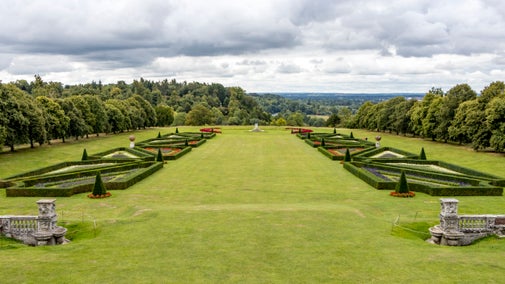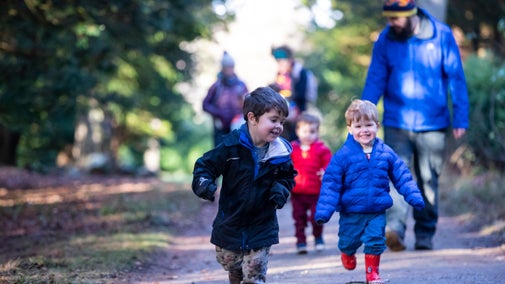
Discover more at Cliveden
Find out when Cliveden is open, how to get here, the things to see and do and more.

Royalty, politics and some of the most prominent society names of the time made Cliveden the place it is today. Once the epicentre of British society, imagine the stories this great estate could tell. Generations of the Royal family have enjoyed its comforts and it has been a political hotbed as well as the scandalous party-house it became known as with the ‘Profumo Affair’.
Cliveden has not only been a residence for members of the British Royal family but as a political powerhouse has hosted royalty from King George I to Queen Elizabeth II.
The military hero of the War of Spanish Succession the Earl of Orkney (1666 – 1737) had close links to the courts of the first two Hanoverian Kings, George I and George II. He was a modest man whose quiet nature and loyalty were rewarded with the appointment to Gentleman of the Bedchamber to George I in 1714. He spent most of his post-military career at Cliveden and his home in Albemarle Street, London. He entertained George I at Cliveden in 1717 and received George II and his family in 1729.
Cliveden was therefore known to the Hanoverian dynasty and George II’s son, Frederick Lewis, Prince of Wales (1707–1751) became the Royal tenant at Cliveden in 1738. Cliveden’s dramatic setting was the perfect backdrop to Fredrick’s counter court to that of his father in London.
Frederick’s major contribution to patriot propaganda was his commissioning of the famous ‘Alfred, a Masque’ written by James Thomson and David Mallet, with music by Thomas Arne.
The event was first performed at Cliveden by the Covent Garden Company in the small amphitheatre in the gardens. The Masque which was open to the public by ticketed admission included the rousing anthem, Rule, Britannia! which remains Frederick's most obvious contribution to Britain's self-image.
Cliveden continued to be at the heart of British power politics when on Queen Victoria's accession in 1837, the Duchess of Sutherland (1806–1868) was appointed Mistress of the Robes. The Duke of Sutherland had purchased Cliveden in 1849 and the Duchess, an ardent Whig and politically liberal, threw herself into her role with vigour. She was a renowned political hostess and close confident of the Queen and a great admirer of the work and ambition of Albert, the Prince Consort.
In recognition of the shared friendship the Queen gifted a statue of Prince Albert to the Duchess in memory of the prince, and the many visits that the Royal couple made to Cliveden in the 1850s.
Like the Duchess of Sutherland, Nancy Astor (1879–1964), drew members of the Royal Family to Cliveden. A hospital had been established in the grounds of Cliveden during the First World War for wounded Canadian servicemen. and King George V and Queen Mary visited in the summer of 1915. The Royal couple would find themselves guests of Nancy in 1924 along with the senior members of Ramsay MacDonald’s Labour government.
George VI and Queen Elizabeth were guests at Cliveden with their two daughters, Princess Elizabeth and Princess Margaret. One estate worker remembered in an oral history how the Royal guests came to a party at Cliveden and how ‘a great big carpet was put out on the terrace so that the guests could dance all night. In the morning everyone was served a cooked breakfast and so enjoyed themselves.’
Although he doesn’t mention whether the Royal Princesses danced through the night, it would be rather sweet to think of our present Queen, as a young girl enjoying the fun at Cliveden during the time of Nancy Astor.
William Waldorf Astor, a well-known American millionaire, bought Cliveden in 1893 for $1.2m. The estate entered a new era with the arrival of the Astors, who were a household name and put Cliveden firmly on the society map.
William Waldorf Astor’s grandfather, John Jacob Astor III, made the family’s fortune through Manhattan property. However, William found that America did not suit him and following time as US Minister to Italy, he decided to make England home.
William Waldorf Astor remodelled many of the rooms within the house, including enlarging the Great Hall and installing the wooden staircase. In 1897 when in Paris, he purchased the so-called ‘French Dining Room’ from the Chateau d’Asnieres, which exactly matched the size of the dining room at Cliveden.
During his time in Italy, Astor had developed a love of classical sculpture and brought many pieces to Cliveden, including the Borghese Balustrade in 1896 and the Fountain of Love in 1897. He created the Long Garden with its topiary to display his Italian statuary and developed an oriental themed water garden with a pagoda, made for the Paris Exhibition of 1867, at its centre. Astor also designed the giant maze for the water garden, which covered over a third of an acre.
Astor’s eldest son, Waldorf, married Nancy Langhorne in 1906 and the couple received Cliveden as a wedding gift. Cliveden entered a new, glittering era as the venue for many parties hosted by the Astors. Cliveden became one of the centres of European political and literary life with guests from Lloyd George, Winston Churchill to George Bernard Shaw, Gandhi and Charlie Chaplin enjoying the lavish hospitality.
Waldorf and Nancy used Cliveden to create powerful networks from the social, political, cultural, and business worlds from both sides of the Atlantic. Things were never stuffy at Cliveden during Nancy’s reign. She was generous, charming and hospitable, and brought many fellow American luminaries to Cliveden such as the great American novelists Henry James and Edith Wharton. She commissioned a bust from the celebrity New York born sculptor Jo Davidson. She entertained the star of the silent screen Charlie Chaplin and enjoyed the company of industrialist Henry Ford. Nancy hosted the leaving party for Joe Kennedy and his family at Cliveden when he resigned his post of American Ambassador to Great Britain in 1940.
In the 1930s the house parties were seen as having a more serious agenda and the group became known as the ‘Cliveden Set’. Newspaper articles accused them of being sympathetic towards Hitler and directing British foreign policy. Prominent Nazi party members did receive invites to Cliveden as did Charlie Chaplin whose outspoken dislike of the Nazi party was well known.
The ‘Profumo Affair’ in 1963 shattered the Astor’s lives. The death shortly afterwards of Waldorf and Nancy’s son Bill hastened the family’s decision to leave Cliveden. Waldorf Astor had given Cliveden to the National Trust in 1942 and in 1966 the Trust took over the management of the estate, opening it to the public.
William Waldorf Astor, encouraged by his friend, the Marquis of Lothian, gifted Cliveden and some of its contents to the National Trust in 1942. He believed that Cliveden should continue to be used as an important meeting place for people from the English-speaking world. He hoped that people from all political persuasions could come together to promote a deeper understanding between Britain and North America.
Waldorf would have been very pleased to see the great American centre of learning, Stanford University lease Cliveden from the National Trust in 1969. The university maintained their British campus at Cliveden for 15 years and countless numbers of young Americans enjoyed living for a few summer months, at the Astors’ former home. Several of the Stanford Alumni Society have returned over the years to share their memories of what many have described as ‘10 weeks to remember’.

Find out when Cliveden is open, how to get here, the things to see and do and more.
For over 300 years Cliveden was home to dukes, earls, viscounts and even a prince. Learn how it became a glittering hub for exclusive parties and political gatherings.

Discover the background and history of some of the main features in the garden at Cliveden and who was responsible for commissioning and designing them.

Discover everything you need to know about booking specialist talks or bringing your group or school for a visit to Cliveden.

If you’re looking to get the whole family outside this winter look no further.

Learn about Harriet, duchess of Sutherland, one of the great society hostesses of the age, and a driving force in re-building the Sutherland properties.
